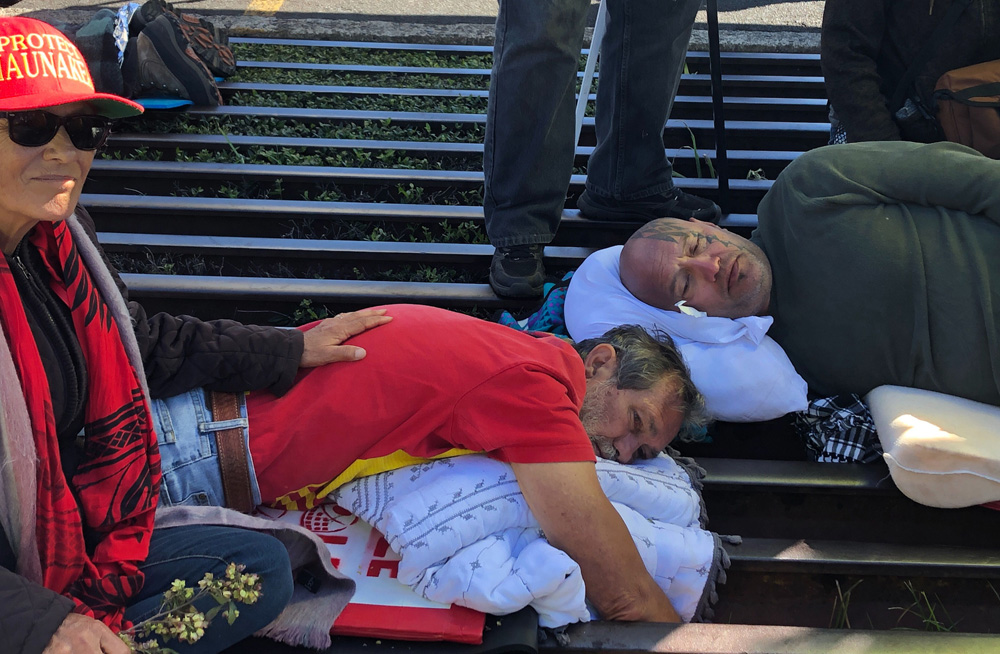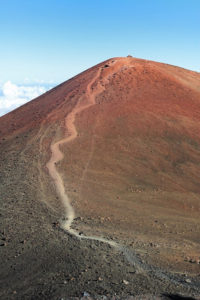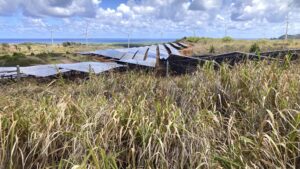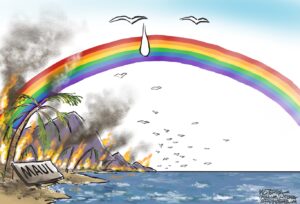Hawaii’s Mauna Kea Protectors Fight for ‘Our Right to Exist’
The survival of an indigenous people and the fate of a crown jewel of world science are at stake atop the world's tallest volcanic mountain. Activist Walter Ritte, center, is among those who chained themselves to a cattle grate to block the road to Mauna Kea, Hawaii, on July 15. (Caleb Jones / AP)
Activist Walter Ritte, center, is among those who chained themselves to a cattle grate to block the road to Mauna Kea, Hawaii, on July 15. (Caleb Jones / AP)
Thirteen thousand feet above the planet’s surface, forces of the sacred and the secular are locked in an epic struggle. At stake are the rights of an indigenous people and the fate of a crown jewel of world science.
The battlefield is the summit of Mauna Kea, a long-dormant volcanic mountain on Hawaii’s Big Island. Native Hawaiians are putting their bodies on the line to stop construction there of the Thirty Meter Telescope (TMT), a massive instrument that would give astronomers unprecedented access to the mysteries of the cosmos.
Many Hawaiians consider Mauna Kea to be sacred ground. They believe that building the world’s largest visible-light telescope atop the 13,803-foot mountain would be a desecration, as well as illegal under state law. Astronomers see the site as ideal for observation of the heavens: Hawaii is the most isolated population center on earth, situated in the mid-Pacific Ocean 2,300 miles from any other significant land mass. The skies are clear, the air is as clean as anywhere in the world and the Big Island’s dark sky law keeps light pollution to a minimum.
The battle to defeat the TMT began as soon as scientists picked the Mauna Kea site in 2009. Past protests have sometimes attracted only a small band of native Hawaiian elders. But, fueled by a cultural renaissance that has helped Hawaiians better understand and cherish their heritage, the movement has grown, blunting the ambitions of an international scientific consortium.
The confrontation escalated last week as the state gave TMT construction a green light. Protesters chained themselves to a cattle grate to block the access road. Thirty-four people, most of them elders, were arrested. Hawaii Gov. David Ige (EE’-gay) declared a state of emergency and called in the National Guard. The controversial move had the effect of galvanizing demonstrators statewide.
By week’s end, a thousand people were rallying at the base of the mountain. Other protests sprang up on the neighboring islands of Oahu, Maui and Kauai. And 3,000 miles away in Utah, more than 150 people gathered in solidarity with the Mauna Kea protectors at a site ceded to Hawaiians by the Mormon church.

The protesters also found some unexpected allies: In an open letter, 200 astronomers and astronomy students affiliated with TMT partner institutions denounced the criminalization of the protectors of Mauna Kea.
By Friday, Ige was sounding conciliatory, but the standoff continued. A TMT spokesman said Sunday the consortium had no plans to back out of the $1.4 billion project.
The conflict has even touched the 2020 presidential campaign. Democratic contender and Hawaii Congresswoman Tulsi Gabbard called on Ige to cancel the emergency order and delay construction.
Jennifer Sinco Kelleher of The Associated Press in Honolulu writes that Mauna Kea, the world’s tallest volcanic mountain, is symbolic of a wider, historical struggle for the rights of native peoples.
[T]he long-running telescope fight encapsulates critical issues to Native Hawaiians: the 1893 overthrow of the Hawaiian kingdom, clashes over land and water rights, frustration over tourism, attempts to curb development and questions about how the islands should be governed.
It’s an example of battles by Native Americans to preserve ancestral lands, with high-profile protests like [the] Dakota Access pipeline leading to arrests in southern North Dakota in 2016 and 2017.
“The TMT and Mauna Kea is just the focal point,” said Hinaleimoana Wong-Kalu, a teacher and cultural practitioner. “For me it’s just a galvanizing element. … It goes back to the role that foreigners played and continue to play in Hawaii.”
Wong-Kalu said the exploitation of Hawaiian culture dates all the way back to the 1700s and Capt. James Cook. “They capitalize and commercialize our culture. … They prostitute the elements that make us Hawaiian. They make it look pretty and make it look alluring in an effort to bring more money into this state.”
“This is about our right to exist,” said Kaho’okahi Kanuha, a protest leader. “We fight and resist and we stand, or we disappear forever.”
Glen Kila of the Marae Ha’a Koa cultural center called Mauna Kea a living, life-giving entity.
“So that’s a different philosophy from the scientific world, that it’s just a mountain that can be used for an observatory. It can be developed,” Kila said. “For us, that’s sacrilegious.”
Your support matters…Independent journalism is under threat and overshadowed by heavily funded mainstream media.
You can help level the playing field. Become a member.
Your tax-deductible contribution keeps us digging beneath the headlines to give you thought-provoking, investigative reporting and analysis that unearths what's really happening- without compromise.
Give today to support our courageous, independent journalists.






You need to be a supporter to comment.
There are currently no responses to this article.
Be the first to respond.